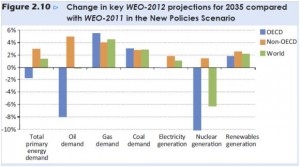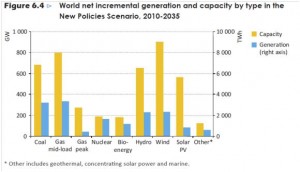The changing face of global energy – Is nuclear power being left behind?
The trouble with trying to read and write about this report is that, as was the case with the Energy Technology Perspectives (which I talked about earlier this year), there is just so much in it to make you think that, agree or disagree, the report is full of interesting information that is worth discussing.
I have been a bit stuck on what perspective to take in this post. Ultimately I decided to focus on some general points this month (of course with the outlook on nuclear as the key talking point) and then I will undoubtedly use the report for future discussions on more focused topics.
Reading the Executive Summary the report starts off with “The global energy map is changing, with potentially far-reaching consequences for energy markets and trade. It is being redrawn by the resurgence in oil and gas production in the United States and could be further reshaped by a retreat from nuclear power in some countries, continued rapid growth in the use of wind and solar technologies and by the global spread of unconventional gas production.”
When it comes to global energy production, this short phrase pretty much sums it up. Strong North American oil production, more coal, less nuclear, more renewables and much more gas. And not surprisingly, this translates into more difficulty meeting climate change objectives. It continues, “Taking all new developments and policies into account, the world is still failing to put the global energy system onto a more sustainable path. Successive editions of this report have shown that the climate goal of limiting warming to 2 °C is becoming more difficult and more costly with each year that passes. Our 450 Scenario examines the actions necessary to achieve this goal and finds that almost four-fifths of the CO2 emissions allowable by 2035 are already locked-in by existing power plants, factories, buildings, etc. If action to reduce CO2 emissions is not taken before 2017, all the allowable CO2 emissions would be locked-in by energy infrastructure existing at that time.” Another testament to the continuing lack of progress on meeting the world’s climate change challenges.
And finally when it comes to the future of nuclear power it recognizes the changes in some countries to cut back while others continue to move forward.
“The anticipated role of nuclear power has been scaled back as countries have reviewed policies in the wake of the 2011 accident at the Fukushima Daiichi nuclear power station. Japan and France have recently joined the countries with intentions to reduce their use of nuclear power, while its competitiveness in the United States and Canada is being challenged by relatively cheap natural gas. Our projections for growth in installed nuclear capacity are lower than in last year’s Outlook and, while nuclear output still grows in absolute terms (driven by expanded generation in China, Korea, India and Russia), its share in the global electricity mix falls slightly over time.”
I am showing all of the above quotes because in a few words from the Executive Summary, the report says so much. The figure below shows the key changes in projected energy use from the 2011 WEO. In summary, as I read this report we can conclude that:
- Fossil fuel use is thriving. Clearly North American policies to increase both oil and gas production are very effective. Coal use is up again globally from the last WEO even with a larger increase in (mostly unconventional) gas use. Fossil fuel subsidies continue to be the largest of any energy source estimated at $523 billion, more than 6 times that for renewables and a 30% increase from 2010.
- Renewables use continues to grow without any real demonstration that increasing renewables to that extent is feasible. Subsidies are at $88 billion and rise to $240 billion in 2035
- Nuclear is being left behind as the 6% reduction in nuclear compared to 2011 is the largest single change in the new WEO New Policies Scenario.
And this path is taking us down the road to being unable to meet the 2 degree climate change scenario. After trying everything else in past reports, this year they try to demonstrate that increased efficiency is a potential path to delaying the inevitable and make time for more policy change to support the environment. This has the potential to extend the 2017 date for lock-in to 2022. However we can also ask, without a real and substantive global commitment to reducing carbon emissions, what will these extra few years actually achieve? Most likely – nothing!
So let’s look at the nuclear case in a bit more detail. Compared to the 2011 scenario, nuclear use is decreasing in those countries with the most to lose, Japan, Germany, Switzerland and even France, while being economically challenged in North America; and rising in the more rapidly growing economies of the east led by China. This leads to an important question. Is nuclear power becoming a transient technology that helps countries develop and then once there, can be phased out over time by a policy shift to renewables? This seems to be a possible theme going forward but in practice nothing can be further from the truth. It is interesting to note that this past week was the 70th anniversary of the first sustained criticality at CP-1 by Enrico Fermi. And here we are today with the countries named above all having substantial nuclear programs providing a large and important part of their electricity generation (Japan 30%, Germany 30%, Switzerland 40% and France 75%). Clearly, with this much nuclear, replacing it is not trivial and will have significant impacts. Even the WEO acknowledges that “shifting away from nuclear power can have significant implications for a country’s spending on imports of fossil fuels, for electricity prices and for the level of effort needed to meet climate targets.”
And that is what we are seeing today as Germany and Japan wrestle with these impacts as they try to reduce the use of nuclear very quickly. Based on hysteria following the Fukushima accident, the politicians in these countries (even France) seem to have forgotten what they have achieved since that famous date 70 years ago and why they built such large nuclear fleets in the first place. Building a successful nuclear program is a major undertaking requiring investment in regulation, infrastructure and industry. Germany, Japan and France have all benefited from this investment as they developed significant technology, know-how and industrial capability with the result being, in all cases, a very large portion of their electricity generation being economical, clean and reliable. Reducing its use as a result of a misguided view on nuclear safety will result in a large negative impact to industry and their economies. In Germany, utilities are suffering financially and in Japan, there is the risk of losing capability and business to the new nuclear powers of Korea and China while having staggering increases in imported fossil fuels and a devastating impact to the local economy.
In fact, looking at the following figure from the WEO shows the bigger story. Just compare the capacity bar with the energy bar in each case and one thing is clear. Nuclear power is a key workhorse of the global energy system. It is by far the most efficient investment as every GW of capacity produces more GWh of energy than every other type of electricity generation. As I stated in my earlier post on the ETP, one of the reasons for the enormous investment in renewables is that you have to build about three times as much capacity as nuclear to get anywhere near the same energy output – and of course even then this energy is not dispatchable. But even looking at the use of more tradition fossil fuels, because nuclear fuel costs are very small, they are dispatched before more expensive coal and gas plants and, as the figure shows, 3 times as much coal capacity and almost 4 times as much gas is projected to each only generate twice the energy as nuclear.
It is important to remember that the WEO is not a forecast per se; rather it is a projection of how government policies would look once implemented. And what we see is a world investing heavily in fossil fuels to protect the status quo while also investing in renewables as a token path to the future. The fall in nuclear power use in developed countries is an important testament to the ongoing impact of the Fukushima accident on government policies in the west.
While the 2012 projection is less than 2011, nuclear power does continue to grow and in 2035 it is projected to supply 12% of world electricity (13% in 2011 projection). Yes, it is being left behind relatively but, as I see it, this report clearly demonstrates the importance of nuclear power as a clean, efficient and reliable source of non carbon electricity going forward. Implementing policies that reduce its use is folly as it definitely will result in expanded fossil use, higher costs, trade imbalances and higher carbon emissions; all leading us down an unsustainable path.
Therefore the policy answer is not to limit and reduce the use of nuclear energy, but to expand its use because even a small expansion in capacity results in a relatively large increase in energy generated. And that means that we need to work harder to address the issues resulting from the Fukushima accident in the developed world and remind those governments who are reacting to short term pressures why they went nuclear in the first place; and of the consequences of reducing its use to their societies so they can rethink potential policies that may move them away from this very important part of our global energy mix.







2 Comments
Noboru Nakao · December 4, 2012 at 9:17 pm
Japan General Election will be on Dec,17.
Although TV and newspaper say that nuclear power should be abandoned and majority of public look like to agree on it, my prediction is completely different.
You may see that nuclear power is still sustained in Japan after the vote.
Nuclear power will never being left behind.
Maury Markowitz · December 10, 2012 at 8:39 am
“Is nuclear power becoming a transient technology that helps countries develop and then once there, can be phased out over time by a policy shift to renewables”
Perhaps. But given that the entire case rests on a single example, China, you have to be careful drawing any conclusions. Especially when one considers that China is deploying much more wind and solar than nuclear. (60 GW of nukes by 2020 – 21 GW of wind *last year*)
But, on the flip-side, it seems that nuclear in China is to some degree, being used as a replacement for a more robust grid. The plants are being put close to new industrial loads where the grid can’t be relied on to bring in power from wind or hydro. So that bears watching.
Comments are closed.